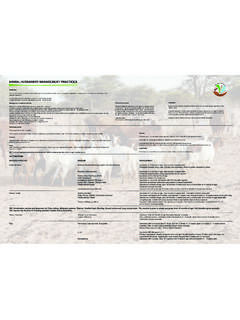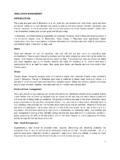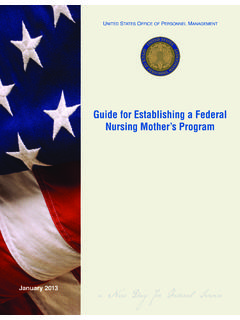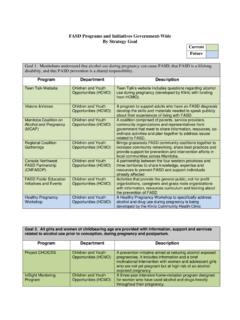Transcription of Charlotte Warren,Pat Daly,Lalla Toure,Pyande Mongi
1 CHAPTER 4 IIIE very year in Africa, at least 125,000 women and 870,000 newborns die in thefirst week after birth , yet this is when coverage and programmes are at theirlowest along the continuum of care. The first day is the time of highest riskfor both mother and baby. The fact that 18 million women in Africa currentlydo not give birth in a health facility poses challenges for planning andimplementing postnatal care (PNC) for women and their of place of birth , mothers and newborns spend most of thepostnatal period (the first six weeks after birth ) at care (PNC) programmes are among the weakest of allreproductive and child health programmes in the region. How can weincrease the coverage of integrated maternal and newborn care in thepostnatal period? What does PNC include, when and where can it beprovided, and by whom?
2 How can we operationalise, improve, and sustainlinkages between homes and hospitals? How can PNC be integrated withexisting strategies and programmes, especially childbirth care, IntegratedManagement of Childhood Illness (IMCI), nutrition promotion, prevention ofmother-to-child transmission of HIV and immunisation? Postnatal careCharlotte Warren, Pat Daly, Lalla Toure, Pyande Mongi80 Opportunities for Africa s NewbornsThe period following birth in Africa is often marked bycultural practices . Understanding these beliefs andpractices is an important part of ensuring effective andtimely care. Many communities throughout Africaobserve practices that keep mothers and babies indoorsfor the first month after birth a period of are wary about visitors coming in close contactwith ;8If mothers or babies become ill duringthe period of seclusion, seeking formal health care is oftendelayed.
3 Yet, sick babies often die within a few hours anddelays can be fatal. Delays also affect maternal crucial delays are outlined in the previous chapteron childbirth care delay in recognition ofcomplications, delay in reaching appropriate care, anddelay in receiving appropriate care. When a baby dies, the women not the men of thefamily perform the burial. It is often taboo to moan andcry during the burial of a newborn or for relatives andfriends to inquire about newborn deaths. In somecountries, it is said that if a newborn baby dies, the babyhas gone back and the baby has not been born yet. Some cultural practices hinder the health and survival ofthe newborn, and young first-time mothers are oftenmost likely to follow these practices . Giving newbornscold baths, discarding colostrum, and providing foodother than breastmilk soon after birth can be butter, ash, or other substances such as cowdung to the umbilical stump increase the risks ofinfection.
4 This chapter will outline the package for PNC anddescribe the current coverage and trends for PNC inAfrica. Then we will explore opportunities to strengthenPNC at the health facility, through outreach, and in thecommunity, and suggest practical actions that will helpaddress key challenges relating to providing quality careto mothers and babies during the critical postnatalperiod. ProblemThe postnatal period defined here as the first six weeks after birth is critical to the health and survivalof a mother and her newborn. The most vulnerable time for both is during the hours and days after of care in this time period may result in death or disability as well as missed opportunities to promotehealthy behaviours, affecting women, newborns, and children:Effects on women:Half of all postnatal maternal deaths occur during the first week after the baby isborn, and the majority of these occur during the first 24 hours after leading cause ofmaternal mortality in Africa accounting for 34 percent of deaths is haemorrhage, the majority of whichoccurs postnatally.
5 Sepsis and infection claim another 10 percent of maternal deaths, virtually all during thepostnatal mothers are at greater risk of postnatal maternal death than to family planning in the early postnatal period is also important, and lack of effective PNCcontributes to frequent, poorly spaced pregnancies (Section III chapter 1). This is a stressful time for newmothers, so emotional and psychosocial support should be available to reduce the risk of on newborns:Sub-Saharan Africa has the highest rates of neonatal mortality in the world and hasshown the slowest progress in reducing newborn deaths, especially deaths in the first week of life. Eachyear, at least million African babies die in the first 28 days of life and 850,000 of these babies do notlive past the week they are claims many babies during the first day, and the majority ofdeaths due to preterm birth occur during the first week.
6 Thirty-eight percent of babies in sub-SaharanAfrica die of infections, mainly after the first week of majority of these deaths are low birthweight(LBW) babies, many of whom are preterm. In addition, long term disability and poor development oftenoriginate from childbirth and the early postnatal on children:At least one in four child deaths occur during the first month of life. These deathsoften take place before child health services begin to provide care, usually at six weeks for the firstimmunisation visit. Low coverage of care in the postnatal period negatively influences other maternal,newborn, and child health (MNCH) programmes along the continuum of care. For example, the lack ofsupport for healthy home behaviours, such as breastfeeding, can have ongoing effects for the child in termsof undernutrition.
7 (Section III chapter 6). Additionally, newborns and mothers are frequently lost to followup during the postnatal period for prevention of mother-to-child transmission (PMTCT) of (Section IIIchapter 7).Opportunities for Africa s Newborns 81 IIIP ackage It has been estimated that if routine PNC and curativecare in the postnatal period reached 90 percent of babiesand their mothers, 10 to 27 percent of newborn deathscould be averted. In other words, high PNC coveragecould save up to 310,000 newborn lives a year in (See data notes on page 226 for more information on thisanalysis) The impact on maternal survival and well beingwould also be significant. There is now more consensus on the content of PNC(what),10;11but questions remain about the best timing (when)and place (where) for postnatal visits, and who can deliver thispackage.
8 Box outlines the current consensus regardingthe what, when, where, and whoof routine PNC. BOX postnatal care (PNC): What, when, where, and who?Preventive care practices and routine assessments to identify and manage or refer complications for bothmother and baby including:Essential routine PNC for all mothers Assess and check for bleeding, check temperature Support breastfeeding, checking the breasts to prevent mastitis Manage anaemia, promote nutrition and insecticide treated bednets, give vitamin A supplementation Complete tetanus toxoid immunisation, if required Provide counselling and a range of options for family planning Refer for complications such as bleeding, infections, or postnatal depression Counsel on danger signs and home careEssential routine PNC for all newborns Assess for danger signs, measure and record weight, and check temperature and feeding Support optimal feeding practices , particularly exclusive breastfeeding Promote hygiene and good skin, eye, and cord care If prophylactic eye care is local policy and has not been given.
9 It is still effective until 12 hours after birth Promote clean, dry cord care Identify superficial skin infections, such as pus draining from umbilicus, redness extending from umbilicus toskin, more than 10 skin pustules, and swelling, redness, and hardness of skin, and treat or refer if the babyalso has danger signs Ensure warmth by delaying the baby s first bath to after the first 24 hours, practising skin-to-skin care, andputting a hat on the baby Encourage and facilitate birth registration Refer for routine immunisations Counsel on danger signs and home careExtra care for low birthweight (LBW) or small babies and other vulnerable babies, such as those born toHIV- infected mothers (two or three extra visits)The majority of newborn deaths occur in LBW babies, many of whom are preterm. Intensive care is not neededto save the majority of these babies.
10 Around one third could be saved with simple care,9including: Identify the small baby Assess for danger signs and manage or refer as appropriate Provide extra support for breastfeeding, including expressing milk and cup feeding, if needed Pay extra attention to warmth promotion, such as skin-to-skin care or Kangaroo Mother Care Ensure early identification and rapid referral of babies who are unable to breastfeed or accept expressedbreastmilk Provide extra care for babies whose mothers are HIV-positive, particularly for feeding support (Section IIIchapter 7).WHAT is routine PNC? 82 Opportunities for Africa s NewbornsEarly identification and referral / management of emergencies for mother and babyAppropriate detection, management, or referrals are necessary to save mothers and babies in the event oflife-threatening complications Danger signs for the mother Excessive bleeding Foul smelling vaginal discharge Fever with or without chills Severe abdominal pain Excessive tiredness or breathlessness Swollen hands, face and legs with severe headaches or blurred vision Painful, engorged breasts or sore, cracked, bleeding nipplesDanger signs for the baby Convulsions Movement only when stimulated or no movement, even when stimulated Not feeding well Fast breathing (more than 60 breaths per minute), grunting or severe chest in-drawing Fever (above 38 C)















